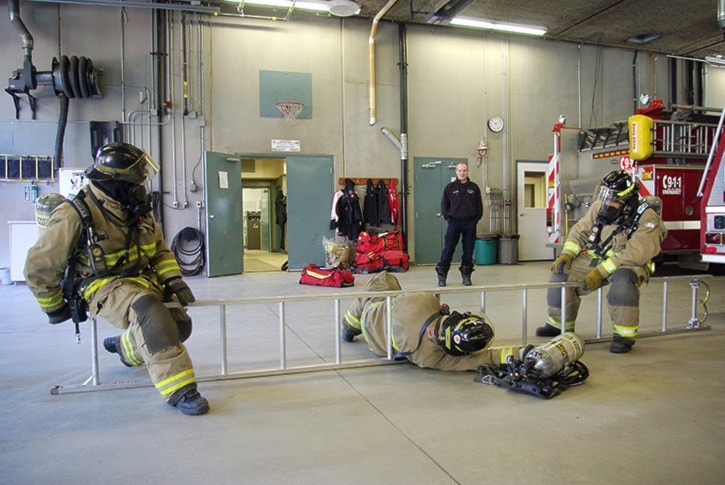Regional fire rescue’s new training requirements have paid on-call and career firefighters working toward the same goal, which comes with an array of challenges.
WorkSafe BC regulations and new legislative requirements in the “playbook” emphasized the need for fully trained firefighters and the liability attached to not having members trained properly. The East End Services Committee reviewed this before setting Kootenay Boundary Regional Fire Rescue as a full-service operations fire department last year.
But with that recognition comes high standards, which are now organized and communicated by Glen Gallamore. The Trail firefighter had over 15 years on the job before stepping into the training officer role in September.
“You can just feel that there is a bit of a different energy now because we’ve kind of gotten to a point now that we’re all going in the same direction, and there is a goal at the end of it,” he told the Trail Times.
He was hired after a fire service review completed by Dave Mitchell and Associates recommended instituting a training officer to bring members up to an NFPA 1001 Level 2 qualification. This course builds on basic training and equips the student to function as an integral member of a team within the required supervision level needed on the fire ground. As well as further knowledge and skills of structural firefighting, the course expectation also provides awareness for basic vehicle extrication and rescue techniques.
Since Gallamore started in the fall, he’s looked at curriculum and implemented a basic program for new recruits as a baseline. He was also quick to create a training matrix as a visual guideline to keep up to date with training achievements of approximately 100 firefighters across the department, which includes paid on-call halls (Rossland, Warfield, Genelle, Trail, Montrose, and Fruitvale) and career staff in Trail.
The “huge undertaking” is no small task, but he continues to chip away with hopes set on helping as many members reach Level 2 standard by the end of next year.
Within each level of training, however, there are hurdles for the rural department to climb. Hazmat training initially required the department to bring in an instructor last fall from the Justice Institute of B.C. to oversee two local instructors before they were recognized as official instructors in the community.
The courses can stretch for days, too, and for those paid on-call firefighters who also have to make time for their real job and family, scheduling can be a nightmare.
Live fire presents other hassles. A teaching environment for simulated vehicle burns, liquid and gas vapor fires and interior attacks is necessary for consistency and safety reasons.
Currently, the department has no choice but to consider traveling to the Coast or the Okanagan to make use of a training facility. But Gallamore thinks building a regional training facility makes most sense logistically, and financially, and notes it was also one of the recommendations delivered in last year’s fire service review.
“We’re the biggest fire department between Calgary and Kelowna as far as numbers, square kilometres, and response requirements go,” he said. “Legally, we’re not allowed to train with a residential structure because it’s not a good teaching environment and it’s extremely dangerous.”
Terry Martin, regional fire chief, acknowledges his team did get permission to execute a structure fire on Riverside Avenue last year, but the controlled burn wasn’t well received by citizens, even with the City of Trail’s strong communication efforts.
On average, it could cost $2,200 per firefighter to attend live fire training out of the area. The expense of sending firefighters elsewhere for one program alone is hefty, not to mention the dollars associated with annual maintenance training expected under the new guidelines.
“When you go to a structure fire now it’s not like before where you just grab anybody hanging around and get them on a hose line and go inside a building,” explained Martin. “That can’t happen anymore. They have to be trained or else there are a lot of liability issues if somebody gets hurt.”
Currently, all 15 career firefighters and 10 paid on-call members dispersed throughout the region are fully qualified to run the whole gambit of fire and rescue services.
“That’s our challenge right now,” clarified Gallamore. “The regional district has chosen for us to become a full-service fire department but our staffing levels, our numbers as far as our qualified firefighters who can carry that mandate, is really low.”
As a result, the department was tasked with coming up with a creative way to stay organized. Regional fire introduced a colour sequence patch system to streamline identifying qualifications in an emergency scenario.
The system starts with red, worn by new members just learning the ropes, and follows with orange, green and, finally, white, which signifies a full-fledged firefighter. Different roles can now easily be assigned based on the colour level strapped to a firefighter’s helmet.
“If we had a major incident in downtown Trail and we had 120 firefighters responding … on the fire ground, it would not be a good time for chief or whoever is in command to start doing job interviews and start figuring out whether or not they’re allowed to go in,” Gallamore explained.
“Ultimately, you want to patch up.”
That has been the response in the region. Though the new requirements can sometimes feel impossible, members are buying into more training and coincidentally recruitment numbers are adding up.
“They don’t want to come to practice and just hang out and maybe drive a truck around the block a couple of times,” said Martin. “They want certified training, and if we can provide it, the interest is exploding.”
